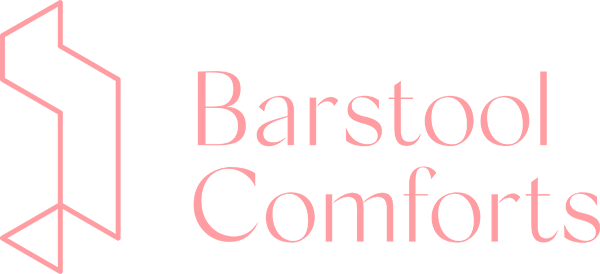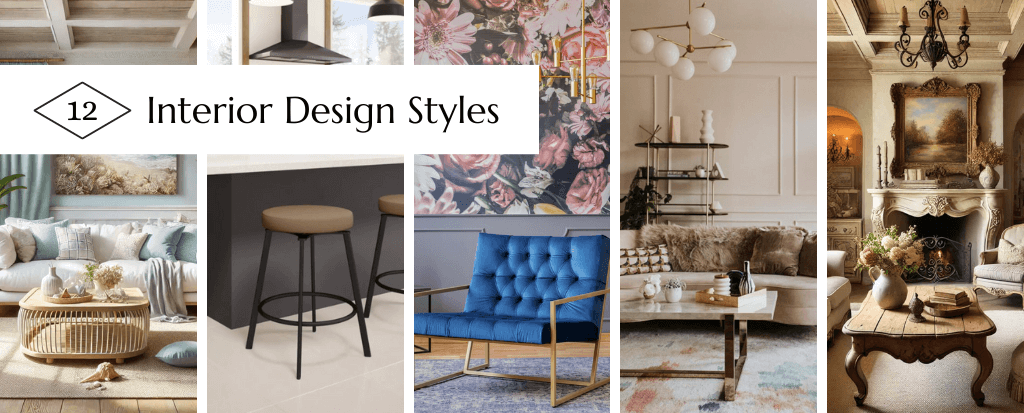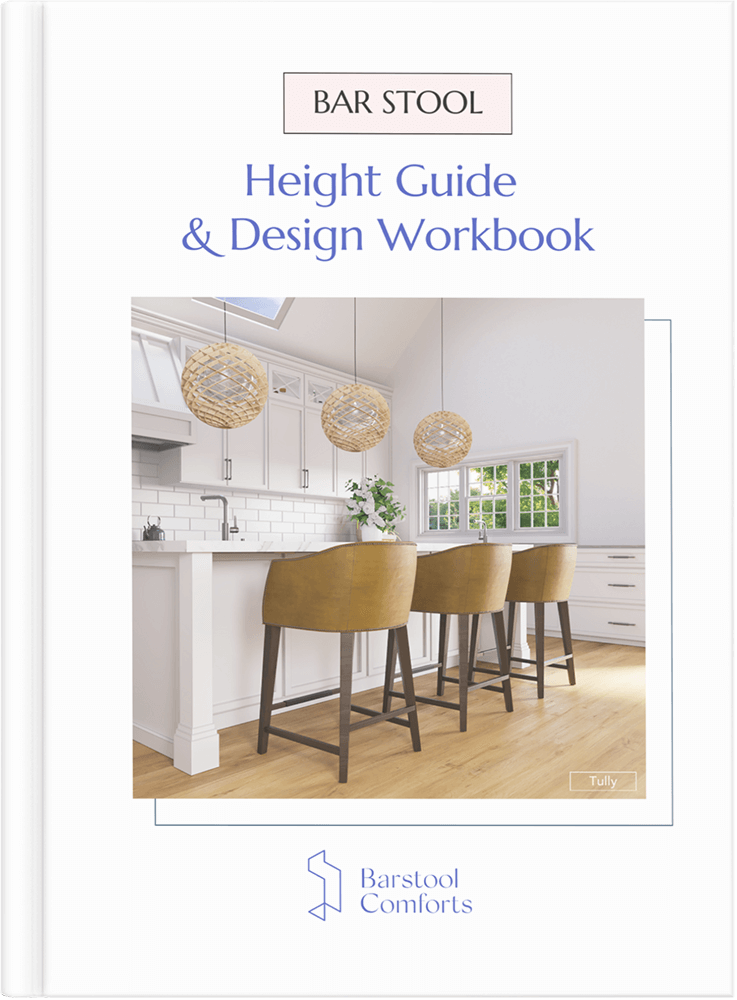This article was updated on July 8 2025
Interior design has this magical way of turning a simple living space into a beautiful, inviting home where memories are made and shared for years.
The Decorating Styles That Shaped Our Homes
Throughout the 20th century, we’ve seen plenty of interior design styles come and go, each leaving a lasting impression on American homes.
From the clean lines of mid-century modern to the raw charm of industrial, knowing the details of these styles helps you bring together a look that feels uniquely ‘you.’
Let’s Get Inspired
Whether you’re looking to give your home a facelift or just want to keep up with the trends (because who doesn’t love design ideas?), here are 12 of the most popular interior design styles:
- Modern
- Farmhouse
- Traditional
- Transitional
- Industrial
- Beach
- French Country
- Scandinavian
- Bohemian
- Maximalism
- Minimalist
- Mid-Century Modern
10 Popular Interior Design Styles
Modern
Clean lines, bold finishes, and a ‘less is more’ vibe are what modern interior design is all about. It’s where contemporary interior design meets practicality, creating a look that’s effortlessly cool without trying too hard.
Origin
The design style came from the Bauhaus school, driven by architects like Le Corbusier and Mies van der Rohe.
Ambiance
The overall sense is openness and flowing in rooms, decorating, and structure, giving an uncluttered, unencumbered relaxed feel.
Color Palette
To complement the sense of spaciousness, the color palette is muted and neutral, typically black, white, and gray.
Decor
The decor itself is minimalistic with occasional color to highlight and incorporates modern style furniture with clean lines made of metals and glass.
Materials
Think chrome, stainless steel, glass, and shiny finishes. Modern style loves mixing metals with smooth, sleek surfaces for that polished, streamlined look.
Farmhouse
Farmhouse style brings cozy and rustic charm right into your space with natural wood and distressed finishes.
Modern & Traditional Farmhouse
Farmhouse style can be divided into two distinct categories: modern farmhouse and traditional farmhouse.
The American farmhouse style is inspired by the simplicity of agricultural life and rustic building techniques with a focus on function and durability.
Furniture
Wood, stone, and exposed beams are typical in farmhouse homes, along with distressed furniture pieces and upholstery as well as plenty of repurposed decor in whites, creams, and soft pastels.
Everyday items like open shelving and large farmhouse sinks add charm while retaining a high level of functionality.
Materials
Reclaimed wood, wrought iron, galvanized metal, and linen. Farmhouse design loves using weathered, natural materials that bring warmth and character.
Traditional
Honed over centuries and drawing inspiration from European design periods like Baroque, Rococo, and Neoclassical, the Traditional style is one of the most popular and timeless.
Style
Formed around symmetry and balance, Traditional interior design favors a formal arrangement of furniture, rich color schemes, elegant textures, patterned fabrics, and ornate details.
Home Decor
Antiques or reproductions, home decor with decorative carvings, and traditional artwork are common in the Traditional style.
You’ll also find heavy drapes and window treatments designed to create a sense of grandeur while at once being intimate and formal.
Ambiance
As one of the timeless classic interior design styles, it embraces elegance and refinement, making spaces feel both luxurious and comfortable.
Materials
You’ll find rich woods like mahogany and cherry, along with leather and brocade, plus those beautiful, intricate carvings. Traditional style loves to embrace luxurious, classic materials that make any space feel effortlessly elegant.
Transitional
Transitional interior design is like the sweet spot between classic charm and modern simplicity.
It’s that perfect mix of timeless pieces and trendy touches, giving your space a look that’s fresh but not over-the-top.
Materials
Wood, glass, and metal, with cozy fabrics like linen or velvet to keep things comfy. Think of it as a design ‘peace treaty’ between traditional and contemporary, where everything just gets along beautifully—and without much fuss!
Industrial
One of the most unique expressions of space, the Industrial interior design, was born in urban industrial centers, where factories and warehouses were turned into living spaces.
Style
A hallmark of the industrial look is exposed elements that highlight the original use and structure of the buildings, such as exposed bricks, pipes, and ductwork.
Other natural elements and reclaimed materials, like piping or reclaimed wood, are incorporated in the decor and furnishings to complement the style.
Industrial is utilitarian at heart, often using salvaged or reclaimed light fixtures and furniture repurposed in unexpected ways.
It continues the minimalist aesthetic of modern design with a focus on function, clean lines, and muted palettes.
Purpose
In most designs, each element is carefully considered and curated for a purpose, but in industrial design, that idea is to highlight the obvious in the open, spacious areas.
Materials
Think exposed brick, concrete, steel, and reclaimed wood. Industrial design loves showing off those raw, utilitarian elements, focusing on durability while keeping things effortlessly rugged.
Beach
A beach day evokes a sense of a sunny, warm, relaxing day. Recapturing those feelings is what beach decor is all about.
Beach style, or coastal interior design, is inspired by the ocean and the goal is to create a laid-back feeling of easy, gentle living.
Coastal style, one of the popular design trends, brings that breezy, laid-back vibe into your home, creating the perfect beach-inspired retreat year-round.
Materials
Light woods like driftwood, wicker, rattan, and soft fabrics like cotton and linen. Beach decor styles typically include nautical themes, such as striped fabrics, tan, blue and green color combinations, to evoke the sand and sea.
Other nautical pieces like boating instruments and sea shells are interspersed to reinforce the theme. style loves natural, airy materials that instantly give off those relaxed, coastal vibes.
French Country
Rooted in the rural homes of Provence, France, and dating back centuries, the French Country style offers a rustic charm.
Patterns
Floral and toile patterns add a romantic touch to French Country spaces and traditionally rural design touches like worn paint and aged wood.
Details
But while French Country is conceptually simple, the magic is in the details: the decorative flourishes in fabrics, carved furnishings, and accent pieces are meant to be reminiscent of handed down and reclaimed pieces that are well lived, well loved, and inviting.
Materials
Distressed wood, wrought iron, toile, and soft linens. French Country design loves mixing weathered, rustic pieces with delicate fabrics and vintage-inspired details for a look that’s effortlessly charming.
Scandinavian
Scandinavian interior design accomplishes the seemingly impossible by making modern, minimalist design warm, cozy, and welcoming.
The simplicity and clean lines of the Scandinavian style, known as Hygge, aim to create comfortable, warm spaces for gathering.
Materials
It uses modern wood and metal, but adds soft materials with rich textures to warm up the space, which is then further emphasized with soft, deliberate lighting.
Lighting
Light is important, especially for a design style built in the Nordic region where it is cold and dark for half the year.
Color Palette
Color is also key. A neutral color palette is used as a foundation to create a sense of lightness, and pops of strong, bright colors liven things up.
Materials
Think light woods like pine and birch, wool, leather, and natural stone. Scandinavian design loves using straightforward, functional materials that help create a space that’s both clean and cozy.
Bohemian
Bohemian style, often called Boho, is all about freedom, creativity, and an eclectic mix of influences.
Style
It’s a style that rejects rigid rules and embraces a more relaxed, personal approach to design.
Inspired by the carefree lifestyle of artists, travelers, and free spirits, Boho decor features vibrant colors, global patterns, and an assortment of vintage and handmade pieces.
Ambiance
It’s a perfect reflection of a laid-back, wanderlust-inspired lifestyle, filled with layered textures, mixed prints, and a sense of individuality.
Materials
Natural elements like rattan, wicker, wood, and jute are frequently used. Textiles play a major role, with materials like cotton, linen, wool, and macramé creating soft layers and adding texture.
Vintage fabrics, kilim rugs, and embroidered pillows are common, often featuring bold patterns and rich colors.
In addition, Boho decor embraces handcrafted items, making use of ceramics, woven baskets, and artisanal objects that bring in a personal and global touch.
Maximalism
Maximalism style embraces boldness and creativity, following the ‘more is more’ philosophy.
No Rules
Maximalism is the style that is most unique because there are few, if any, rules. You be you, and be comfortable. Beyond that, let your creativity soar.
Style
Maximalism embraces bold patterns, textures, and bright colors, often featuring oversized florals, geometric shapes, and animal prints.
It draws inspiration from ornate Baroque designs, mixing luxurious details with cultural motifs from around the world.
Abstract and pop art often serve as focal points, while whimsical elements like mythical creatures or exotic animals add drama. The style thrives on layering and contrasts, creating a vibrant, eclectic space full of personality.
Materials
Velvet, bold patterned fabrics and textiles, mixed metals, and layered textures. Maximalism thrives on a mix of luxurious and eclectic materials, creating a vibrant, eye-catching look.
While eclectic and maximalism share similarities, they are not exactly the same.
Maximalism embraces a “more is more” approach, using bold colors, patterns, and layers to create vibrant, dramatic, and often extravagant spaces.
Eclectic design, on the other hand, focuses on thoughtfully blending different styles, eras, and influences to create a cohesive look. It can be subtle or bold but is typically more curated and balanced than maximalism.
In essence, eclectic design mixes elements in a harmonious way, while maximalism focuses on making a bold, eye-catching statement through visual abundance.
Maximalism and Bohemian style share similarities, such as a love for layering, rich textures, and bold expression, but they differ in key ways.
Maximalism embraces a “more is more” philosophy, combining bold colors, patterns, and textures in a dramatic and sometimes extravagant way. Its goal is to make a bold statement and create a sense of visual abundance.
On the other hand, Bohemian style is more laid-back and free-spirited, influenced by global and vintage aesthetics. While it also mixes patterns and textures, Boho tends to feel more relaxed and earthy, using natural materials and eclectic decor from around the world. Rather than excess, Bohemian style focuses on creating a cozy, personal space that reflects artistic expression and wanderlust.
Minimalist
Minimalism became popular in the mid 20th century and merges Bauhaus concepts with Eastern philosophies, especially Zen.
Simplicity and functionality are the focus of the Minimalist interior design style. That comes through in fewer items, less clutter (think: no more curio cabinets!), and clean lines.
Style
Minimalist style is more about using what is available, from decor and furnishings to lighting.
Rather than recreating natural light, it’s better to allow it in and open up the space by removing non-essential items. The relaxing and inviting feeling of the design is created through the ease and comfort of the space.
Purpose
Efficient, purposeful use of the space allows you to become part of your surroundings rather than paying attention to them.
Color Palette
A neutral color palette is often key to achieving this look, enhancing the sense of simplicity and calm.
Materials
Polished concrete, natural wood, glass, and matte finishes. Minimalist design favors simple, sleek materials to maintain a clean and serene atmosphere.
Mid-Century Modern
Mid-Century Modern design combines elements of other styles to create a “livable” medium that has become its own movement.
It incorporates the modern and minimalist look with clean lines and organic shapes, but also brings in comfort and bold colors.
Style
The underlying theme of Mid-Century Modern is warm and inviting.
The shapes, angles, and styles appeal to our innate need for geometric balance and patterns.
Ambiance
Space and light are used strategically to give a sense of openness and a place for gathering. The warmth isn’t just in the design elements; it’s how the style makes us feel.
It’s a nod to the 1950s and 60s, but its timeless charm still feels right at home in today’s spaces.
Materials
Teak, walnut, molded plastic, and fiberglass. Mid-Century Modern blends warm wood with bold colors and retro-inspired synthetic materials, creating a look that’s both classic and fresh.
How to Choose the Right Interior Design Style
Your home is your castle and a reflection of you—your likes, passions, and personality. But it is also where you live, so it needs to be a place where you can be your authentic self. So choosing a design style may be more about letting one choose you.
Choosing the right interior design style starts with understanding your personal taste and lifestyle.
Do you gravitate towards the sleek, modern design of Art Deco interiors, or does the eclectic charm of Bohemian or Boho décor speak to you?
Set the Tone
Consider the atmosphere you want to create in your home – whether you prefer a cozy shabby chic living room or the streamlined look of a minimalist interior.
A neutral color scheme with clean lines may suit those seeking simplicity and serenity, while the layering of bold patterns in a maximalist space appeals to those who love vibrant, expressive design elements.
Evaluate Existing Furniture Décor
Next, evaluate your existing furniture pieces and décor.
Does your home decor already lean toward a specific style, such as modern farmhouse, industrial interior design, or traditional interior design?
Incorporating what you already have can make the transition easier and more budget-friendly.
Drawing inspiration from your surroundings, such as the natural elements of a Nordic or Scandinavian interior design, can also guide your choices.
Mix & Match Interior Design Styles
Blending different styles is also an option. You can mix coastal interior design with transitional style or add touches of Hollywood glam to a 19th-century style home.
Creating balance is key, and even incorporating retro vibes from mid-century modern design or Japanese influences can result in a truly unique home design.
We’re Here to Help
If you’re feeling uncertain or overwhelmed by the different types of interior design styles, we’re here to help!
Reach out to us for expert advice and personalized guidance on choosing the perfect home design and decor ideas that align with your vision and lifestyle.




